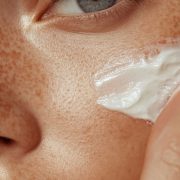When the ‘gold standard’ ingredients backfire—and what to try instead
Posted on August 5, 2025 Written by: 100% PURE®

If you’ve spent any time researching skincare, you’ve heard it countless times: retinol is the gold standard for anti-aging, and vitamin C is essential for brightening and protection. These ingredients dominate dermatologist recommendations, skincare forums, and beauty editor favorites lists. The message is clear—if you’re serious about skincare, you need these powerhouse actives in your routine.
But what if you’re one of the many people whose skin rebels against these celebrated ingredients? What if, despite your best efforts to push through the “adjustment period,” retinol leaves you perpetually peeling and vitamin C turns your face into an irritated mess? You’re not alone, and more importantly, you’re not doomed to subpar skincare results.
The truth is, some people genuinely look better without these supposedly essential ingredients. Their skin thrives on gentler alternatives that work with their unique biology rather than against it. Let’s explore why these gold standard ingredients don’t work for everyone and discover the alternatives that might transform your skin where retinol and vitamin C failed.
The Retinol Reality Check
Retinol and its prescription cousins (tretinoin, adapalene) have earned their reputation through decades of research. They accelerate cell turnover, boost collagen production, and can dramatically improve skin texture and tone. For many people, they’re genuinely transformative. But for others, the story is quite different.
The experience of struggling with retinol for months or even years, trying different strengths and application methods, only to face constant redness and peeling, is surprisingly common. Many people find themselves caught in an endless cycle of irritation, waiting for an adjustment period that never truly ends.
Why Retinol Fails for Some
Genetic Sensitivity Some people have genetic variations that make their skin hyperreactive to retinoids. Their cell turnover mechanisms respond too aggressively, leading to chronic inflammation rather than controlled renewal.
Compromised Barrier Function If your skin barrier is already weakened—whether from genetics, environment, or other factors—retinoids can exacerbate the problem. Instead of strengthening skin over time, they perpetuate a cycle of damage and incomplete repair.
The Endless Purge While some experience a brief adjustment period, others find themselves in a perpetual tretinoin purge that never resolves. Months or even years later, they’re still dealing with irritation and breakouts, waiting for the promised “glow” that never comes.
Lifestyle Incompatibility Retinoids increase photosensitivity and require diligent sun protection. For those with outdoor lifestyles or living in sunny climates, the increased vulnerability might outweigh the benefits.

The Vitamin C Conundrum
Vitamin C faces similar challenges. While it’s a potent antioxidant with proven brightening benefits, many people experience vitamin C reactions that range from mild irritation to severe sensitivity. The problems with vitamin C are multifaceted:
pH Sensitivity
L-ascorbic acid, the most studied form of vitamin C, requires a low pH (around 3.5) to remain stable and effective. For sensitive skin, this acidic environment can be too harsh, leading to redness, stinging, and compromised barrier function.
Oxidation Issues
Vitamin C serums are notoriously unstable. When they oxidize, they not only lose effectiveness but can actually cause irritation and potentially harmful free radical formation—the opposite of their intended effect.
Individual Intolerance
Some people simply can’t tolerate vitamin C in any form. Whether it’s pure L-ascorbic acid or gentler derivatives, their skin responds with irritation, breakouts, or allergic reactions. This isn’t a failure of proper usage—it’s biological incompatibility.
The Citrus Sensitivity Connection
Those with citrus allergies or sensitivities often find they can’t tolerate topical vitamin C either. The connection between dietary and topical sensitivities is complex but real for many individuals.
Signs These Ingredients Aren’t for You
How do you know if you should break up with retinol or vitamin C? Watch for these persistent signs:
With Retinol:
- Chronic redness that doesn’t improve with time
- Persistent peeling beyond the initial adjustment period
- Increased sensitivity to other products and environmental factors
- Worsening texture or breakouts that don’t resolve
- Eye area irritation that affects your quality of life
- Inability to wear makeup due to constant flaking
With Vitamin C:
- Immediate stinging or burning upon application
- Red, inflamed patches where product is applied
- Breakouts in areas where you don’t typically break out
- Increased photosensitivity despite the antioxidant properties
- Allergic reactions like hives or swelling
- Orange staining on skin or pillowcases
If you’ve experienced these symptoms for more than 12 weeks despite proper usage, it’s time to consider alternatives.
The Alternative All-Stars
The good news is that skincare has evolved beyond the retinol-and-vitamin-C paradigm. Innovative ingredients and formulations can deliver similar benefits through different mechanisms, often with better tolerance. Let’s explore your options:
Bakuchiol: The Plant-Based Retinol Alternative
Bakuchiol has emerged as a legitimate retinol alternative, backed by clinical studies showing comparable results without the irritation. Derived from the babchi plant, it stimulates collagen production and accelerates cell renewal through different pathways than retinoids.
The 100% PURE Bakuchiol Cleanser introduces this ingredient in a gentle, non-irritating format. Unlike leave-on retinol treatments that can overwhelm sensitive skin, a bakuchiol cleanser provides benefits during the cleansing step, then rinses away—perfect for building tolerance or for those who can’t handle leave-on actives.
Matcha and Green Tea: Antioxidant Powerhouses
For those who can’t tolerate vitamin C, matcha and green tea extracts offer potent antioxidant protection without the low pH requirement. These ingredients fight free radicals, reduce inflammation, and can even help with hyperpigmentation—many of the same benefits attributed to vitamin C.
The 100% PURE Matcha Oat Milk Nourishing Mask exemplifies this approach. The combination of antioxidant-rich matcha with soothing oat milk provides protection and nourishment without the irritation risk of acidic vitamin C formulations. Used once or twice weekly, it delivers cumulative brightening and protective benefits.
Fermented Ingredients: The Gentle Exfoliators
For those seeking retinol-like cell turnover benefits without the harsh side effects, fermented ingredients offer an intriguing alternative. Black tea ferment, in particular, provides gentle exfoliation and antioxidant benefits while actually supporting barrier function rather than compromising it.
The 100% PURE Black Tea Grass Jelly Moisturizer harnesses these benefits in a deeply nourishing formula. The fermented black tea helps refine texture and boost radiance, while the grass jelly provides cooling, calming effects—the opposite of retinol’s often inflammatory action.
Soothing Actives: The Inflammation Fighters
Sometimes the best approach is to focus on calming inflammation rather than aggressive treatment. Ingredients like oat extract, centella asiatica, and lavender can improve skin health by reducing irritation and supporting natural repair processes.
The 100% PURE Lavender Oat Milk Soothing Cleanser embodies this philosophy. Instead of stripping skin or delivering harsh actives, it gently cleanses while actively soothing—perfect for those whose skin is exhausted from failed attempts with traditional actives.
Caffeine: The Targeted Treatment
For specific concerns like dark circles and puffiness, caffeine can be more effective than retinol or vitamin C. It works by improving circulation and providing antioxidant benefits without the irritation risk of traditional actives.
The 100% PURE Coffee Bean Caffeine Eye Cream demonstrates how targeted ingredients can outperform “gold standard” options for specific areas. The delicate eye area often can’t tolerate retinol or vitamin C, but caffeine provides visible results without sensitivity.

Alternative Ingredients Worth Exploring
Beyond the products mentioned, several other ingredients deserve consideration:
Azelaic Acid
This naturally occurring acid provides many benefits of retinoids and vitamin C—improving texture, fighting acne, and brightening—but with better tolerance. It’s particularly effective for rosacea-prone skin that can’t handle traditional actives.
Peptides
These amino acid chains stimulate collagen production like retinoids but through gentler mechanisms. They’re particularly effective in combination with other soothing ingredients.
Niacinamide
This vitamin B3 derivative brightens, strengthens the barrier, and regulates oil production. Unlike vitamin C, it works at a skin-friendly pH and actually helps reduce sensitivity.
PHAs (Polyhydroxy Acids)
These gentle chemical exfoliants provide cell turnover benefits similar to retinoids but with a larger molecular size that prevents deep penetration and irritation.
Building Your Alternative Routine
Ready to explore life without retinol and vitamin C? Here’s how to build an effective routine with alternatives:
Morning Routine
- Gentle Cleanse: Use a soothing cleanser like the Lavender Oat Milk option
- Antioxidant Protection: Apply products with green tea, matcha, or other stable antioxidants
- Moisturize: Choose formulas with barrier-supporting ingredients
- SPF: Never skip sun protection, especially when using any active ingredients
Evening Routine
- Bakuchiol Cleanse: If using bakuchiol, a cleanser format is gentler than leave-on treatments
- Treatment: Apply fermented ingredients or gentle actives
- Eye Care: Use targeted treatments like caffeine for specific concerns
- Night Moisturizer: Focus on repair and nourishment
Weekly Additions
- Use masks with matcha or other antioxidants 1-2 times per week
- Consider gentle enzyme exfoliants instead of acid exfoliants
- Incorporate facial massage to boost circulation naturally
The Science Behind Alternative Ingredients
Understanding why alternatives work helps justify the switch:
Different Pathways, Similar Results
Bakuchiol activates similar genetic pathways to retinol but through different mechanisms. This means you get collagen stimulation and improved cell turnover without triggering the inflammatory cascade that retinoids can cause in sensitive individuals.
Broader Spectrum Protection
While vitamin C is a single antioxidant, ingredients like green tea extract contain multiple antioxidants (catechins, polyphenols) that work synergistically. This can provide more comprehensive protection without the irritation risk of high-concentration single actives.
Supporting vs. Forcing
Traditional actives often work by forcing dramatic changes in skin behavior. Alternatives tend to support and enhance natural processes. This gentler approach may take slightly longer but often leads to more sustainable results.
Common Concerns About Switching
“But won’t I age faster without retinol?” Not necessarily. Chronic inflammation from poorly tolerated retinol can actually accelerate aging. Calm, healthy skin ages better than constantly irritated skin, regardless of what actives you’re using.
“How can I get bright skin without vitamin C?” Many ingredients brighten skin—niacinamide, licorice root, kojic acid, azelaic acid, and various botanicals. You might find these work better for your skin type than vitamin C ever did.
“What about scientific backing?” While retinol and vitamin C have the most research, alternatives like bakuchiol are accumulating impressive clinical data. Moreover, ingredients with centuries of traditional use (like green tea) have different but valid forms of evidence supporting their effectiveness.
“Will I see results as quickly?” Gentle alternatives often work more gradually than aggressive actives. However, because they don’t require recovery periods from irritation, the cumulative results can be equally impressive.
When to Make the Switch
Consider abandoning retinol or vitamin C if:
- You’ve tried for 3+ months with no improvement in tolerance
- Your skin looks worse than before you started
- The side effects impact your quality of life
- You dread your skincare routine
- Your skin never feels calm or comfortable
- You’re constantly dealing with peeling or sensitivity
The Holistic Approach
Sometimes the best anti-aging strategy isn’t about powerful actives but overall skin health:
Barrier Support: A healthy barrier function naturally improves texture and radiance Inflammation Control: Reducing chronic inflammation can be more anti-aging than any active Consistency: Gentle products used consistently often outperform aggressive treatments used sporadically Lifestyle Factors: Sleep, hydration, and stress management might improve your skin more than any serum
Embracing Your Skin’s Preferences
The skincare industry’s focus on “gold standard” ingredients can make us feel like failures when they don’t work for us. But skin is individual, and what works for most people might not work for you. This isn’t a flaw—it’s biology.
Some people thrive on gentle botanicals while others need prescription-strength actives. Some get amazing results from bakuchiol while others see no difference. The key is paying attention to your skin’s responses rather than forcing it to accept ingredients it clearly dislikes.
The Professional Perspective
Many dermatologists and estheticians are recognizing that the one-size-fits-all approach to actives doesn’t serve everyone. They’re increasingly recommending alternatives for patients who struggle with traditional ingredients, noting that inflamed, compromised skin can’t benefit from even the most proven actives.
The shift in professional thinking reflects a broader understanding that skincare success isn’t just about using specific ingredients—it’s about finding what works for individual skin. This might mean embracing alternatives that weren’t part of the traditional skincare canon but deliver results without the suffering.
Your Path Forward
If you’ve struggled with retinol or vitamin C, know that you’re not alone and you’re not limited. The expanding world of alternative ingredients offers numerous paths to healthy, radiant skin. Whether you choose bakuchiol, fermented ingredients, botanical antioxidants, or simply soothing skincare, the goal remains the same: skin that looks and feels its best.
Remember, the best skincare routine is one you can maintain comfortably long-term. If that means saying goodbye to traditional actives and embracing alternatives, you might find—like many others have—that your skin looks better without the “gold standard” ingredients than it ever did with them. Sometimes the most radical thing you can do for your skin is to stop fighting against its nature and start working with it instead.




